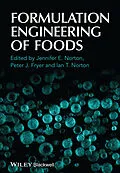Formulation Engineering of Foods provides an in-depth look at formulation engineering approaches to food processing and product development of healthier, higher-performance foods.
Through the use of eye-catching examples, such as low fat and low calorie chocolate, and salt reduction strategies in products like cheese and sauces, the book is at once easy to relate to and innovative. Presenting new methods and techniques for engineering food products, this book is cutting edge and as food formulation is a new method of food science, this is a timely publication in the field.
All three editors are based in the University of Birmingham, base of the largest Chemical Engineering-based food research group in the UK, incorporating research into structured foods, flavour delivery and food hygiene. Research in food processing is carried out in partnership with key companies such as Nestlé, Unilever and Cadbury, as well as through funding from research councils and DEFRA. Joint research and collaboration has been carried out with Food Science departments at Nottingham, Leeds and Reading.
Autorentext
About the Editors
Jennifer E. Norton is a Post Doctorate Research Fellow in the School of Chemical Engineering at the University of Birmingham.
Peter J. Fryer is Professor of Chemical Engineering at the University of Birmingham.
Ian T. Norton is Professor of Microstructural Engineering at the University of Birmingham.
Klappentext
Formulation Engineering of Foods
Edited
by Jennifer E. Norton, Peter J.
Fryer and Ian T. Norton
Food products are often structurally complex. This structure, or microstructure, determines the food's flavour, texture and mouthfeel, and the pleasure derived from its consumption, in addition to the efficiency of uptake during digestion, the bioavailability of active compounds, and the effect it has on appetite and satiety. Given the health issues of the modern age, including the prevalence of obesity, food research is often heavily focused on fat reduction, or methods of reducing the uptake of fat or slowing digestion, whilst maintaining sensory appeal, and palatability. A combined understanding of material chemistry and material science is needed, together with an understanding of how processing affects food structure, the science behind food consumption, from oral processing through to digestion, and the impact that food formulation engineering can have on liking, sensory perception, digestion, targeted delivery, or appetite. Formulation Engineering of Foods aims to provide the reader with detailed reviews of the literature in these areas.
The book is separated into three main sections. The first part of the book, Designing Structured Foods, considers how basic materials can be used to formulate complex food systems, with specific structures, desirable sensory attributes and health benefits. In the second part, Structure-Human Interaction, the authors consider the interaction between the food and the human body, and how foods can be designed to get the greatest positive impact (in terms of oral processing and/or digestion) when producing healthier, more convenient, and/or more environmentally friendly products.The third part, Food Structure and the Consumer, considers consumer psychology, and the impact that food can have on liking and acceptability, and on appetite and satiety.
Formulation Engineering of Foods is essential reading for food scientists and engineers, food product designers and food developers. It will also be increasingly relevant to academics highlighting the current state of the art and possible areas for future research (particularly multidisciplinary research), and to the food industry where there is demand for greater control and design of food products that provide functionality through formulation and structure. This will therefore be a required book for libraries in all
institutions where food science and technology are taught or implemented.
Also available
Practical Food Rheology: An Interpretive Approach
Edited by I.T. Norton, F. Spyropoulos and P. Cox
ISBN 978-1-4051-9978-0
Food Materials Science and Engineering
Edited by B. Bhandari and Y. Roos
ISBN 978-1-4051-9922-3
Dense Phase Carbon Dioxide: Food and Pharmaceutical Applications
Edited by M.O. Balaban and G. Ferrentino
ISBN 978-0-8138-0649-5
Zusammenfassung
Formulation Engineering of Foods provides an in-depth look at formulation engineering approaches to food processing and product development of healthier, higher-performance foods.
Through the use of eye-catching examples, such as low fat and low calorie chocolate, and salt reduction strategies in products like cheese and sauces, the book is at once easy to relate to and innovative. Presenting new methods and techniques for engineering food products, this book is cutting edge and as food formulation is a new method of food science, this is a timely publication in the field.
All three editors are based in the University of Birmingham, base of the largest Chemical Engineering-based food research group in the UK, incorporating research into structured foods, flavour delivery and food hygiene. Research in food processing is carried out in partnership with key companies such as Nestlé, Unilever and Cadbury, as well as through funding from research councils and DEFRA. Joint research and collaboration has been carried out with Food Science departments at Nottingham, Leeds and Reading.
Inhalt
List of Contributors vii
1. Introduction to Food Formulation Engineering 1
J.E. Norton, P.J. Fryer and I.T. Norton
2. Protein-Based Designs for Healthier Foods of the Future 9
G. Keith Harris and E. Allen Foegeding
3. Design of Foods Using Naturally Structured Materials 44
T.J. Foster
4. Designed Food Structures Based on Hydrocolloids 59
B. Wolf
5. Formulation Engineering of Food Emulsions 82
A.K. Pawlik, P.J. Fryer and I.T. Norton
6. The Physics of Eating 107
P. Lillford
7. Design Structures for Controlled Manipulation of Flavour and Texture 136
B.J.D. Le Révérend, O. Gouseti and S. Bakalis
8. Salt Reduction in Food 163
T.B. Mills and I.T. Norton
9. Food Structures Designed for Oral Response/Flavour Release 174
R. Linforth
10. The Colloidal State and its Relationship to Lipid Digestion 196
M. Golding
11. Hydrocolloid Formulations Engineered for Properties in the GI Tract 233
F. Spyropoulos and E. Nowak
12. Design of Food Structures for Consumer Acceptability 253
J.E. Norton
13. Formulation Design to Change Food Habits 281
J.A. Harrold and J.C.G. Halford
Index 309
